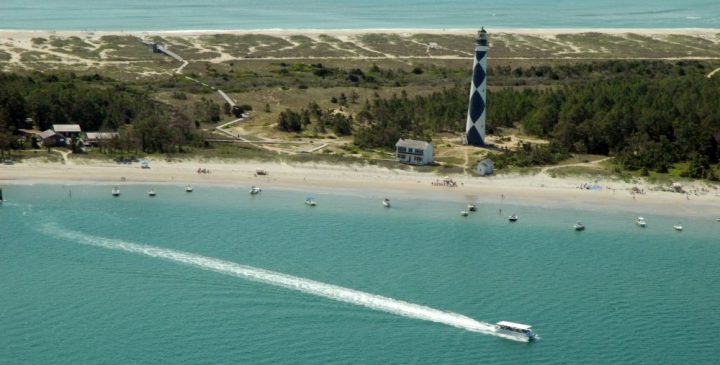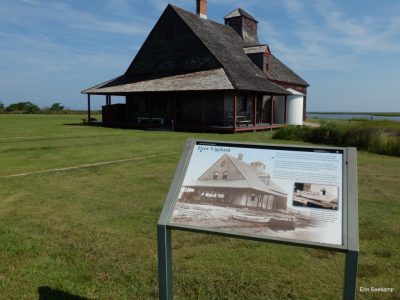
CARTERET COUNTY – Researchers from North Carolina State University in Raleigh, working with the National Park Service and other partners, are using the Cape Lookout National Seashore as the site for a study to determine how climate change might affect key cultural resources over time, and what can be done.
Cape Lookout is a particularly interesting choice for the study because many folks who live nearby have deep emotional and ancestral ties to the islands that make up the park. Lead investigator Erin Seekamp, an associate professor and tourism extension specialist in the Department of Parks, Recreation and Tourism Management at NCSU, says she and the others involved are quickly learning a lot.
Supporter Spotlight

“Many of the people we’ve talked to so far have deep connections to the islands and the places and structures on them, and they care about them a lot,” Seekamp said. “Part of what we and the park service want to know is what they think climate change endangers the most. But we also want to know what structures they view as most important, and which ones they view as most important to protect, and how best to do that.”
The Cape Lookout National Seashore preserves a 56-mile-long section of the southern Outer Banks, running from Ocracoke Inlet on the northeast to Beaufort Inlet on the southeast. Three undeveloped barrier islands make up the seashore: North and South Core Banks and Shackleford Banks. It includes two historic villages on Core Banks, Shackleford’s wild horses and the Cape Lookout Lighthouse, which is one of the most iconic in the country.
But a real key, to folks who don’t come to the seashore from “off” – Down East Carteret County residents’ term for many visitors – is historic Portsmouth Island Village, on wind- and water-swept Core Banks, the ancestral home of many residents of the area. It was founded in 1753, and was key “lightering port,” where oceangoing vessels could offload cargo for transport on smaller vessels through Ocracoke Inlet to villages along Core and Pamlico sounds. There was a key lifesaving station there, and by 1860, it was home to nearly 700 people. During the rest of the 1800s, the island village was beset by numerous hurricanes, shoaling in the inlet and the closure of the lifesaving station and the post office. By 1967, it had become part of the national seashore, and the last two residents left in 1971.
The national seashore was authorized on March 10, 1966, and the park service took over the properties that once belonged to those “ancestors.” There’s still bitterness.
Seekamp said she and the others involved realize the importance of the history to many folks whose ancestors once lived and worked there, and they’ve been working with the Core Sound Waterfowl and Heritage Museum on Harkers Island and other stakeholders to get their opinions. That’s part of what the study is all about.
Supporter Spotlight
They’ve done oral surveys of many, including those visiting at the lighthouse, at the national seashore’s visitor center on Harkers Island and in Portsmouth Village, and have asked those surveyed what they’ve been most interested in as an attraction and most interested in protecting.

Modeling based on projected climate change shows that not only the lighthouse but almost everything in the park is within the “high vulnerability” range by 2100, some by 2050. About the only thing that looks close to safe within that time range is the old Coast Guard Station, which is in the in the “moderate” risk zone.
Seekamp and others are evaluating 17 buildings in all on the seashore, and are also working with the State Historic Preservation Office. The research team, which includes U.S. Geological Survey analysts Mitch Eaton and Max Post van der Burg, is combining this information with earlier research by Western Carolina University’s Rob Young at the Center for the Study of Developed Shorelines.
Seekamp said the goal is to help the park service prioritize which structures residents and visitors consider most important to protect, and what steps to protect them they would support.
The researchers have asked about such options as beach re-nourishment, elevating structures or moving them, or simply fencing them off and letting nature takes its course.
Interestingly, so far, Seekamp said, relatively few respondents seem invested in elevation; they feel that option would undermine the things that underpin their attachments. Nor, she said, do they seem particularly interested in moving structures. Other options include using traditional, or even non-traditional, materials to “shore up” the structures to enable them to withstand bigger and more frequent flood events.
“I’m glad that someone is trying to determine what might be done,” said one descendent of so-called “Ca’e Bankers.” “These places aren’t just buildings. They are heritage, roots, to lots of people. But at the same time, some people don’t really want the park service or anyone else to mess with them.”
But the studies also involve the Southeast Climate Center at NCSU, which is affiliated with the U.S. Department of the Interior. It is one of eight regional Climate Science Centers managed by the U.S. Geological Survey National Climate Change and Wildlife Science Center, and works with natural and cultural resource managers to gather the scientific information and build the tools needed to help fish, wildlife, and ecosystems adapt to climate change.
In other words, it’s not just about Cape Lookout. An abstract of the effort puts it this way: “Climate change doesn’t just threaten our natural resources – it threatens our cultural resources, too. Cultural resources represent evidence of past human activity, such as archeological sites, or are of significance to a group of people traditionally associated with the resource, such as Native American ceremonial sites.

“Climate change is challenging the long-term persistence of many cultural resources. For example, those located in coastal areas, such as historic lighthouses, are threatened by sea-level rise, shoreline erosion, and more frequent severe storm events. While climate change challenges managers of both natural and cultural resources to make decisions in the face of uncertainty, far less work has been done to identify the impacts of climate change on cultural resources, compared to natural resources.”
The Cape Lookout study is an attempt to develop a planning model, of sorts, based on a “subset” of buildings at the national seashore that are listed on the National Historic Register, according to the project abstract.
“Cultural resources hold multiple and diverse values to local communities, visitors, and the general public,” the abstract states. “These resources are irreplaceable, and their meaning is often tied to their specific location. This project will contribute significantly to our understanding of the vulnerability of cultural resources to climate change throughout the southeastern U.S. and the role that historic significance should play in management decisions – information that is vital for developing strategies to conserve these resources into the future.”
All of this is important because there is a tremendous backlog – some say as much as $11 billion – in needed repairs in national parks.
“It’s certainly not isolated to Carteret County or eastern North Carolina,” Seekamp said. Cape Lookout made a good study area because it is a system of barrier islands, particularly vulnerable to harsh weather, and now, increasingly, to sea-level rise associated with climate change.
There will be workshops, Seekamp said, “to try to find ways to optimize decision-making on a larger scale, not just North Carolina.” Analysts will use vulnerability models for the next 30 years to try to plug in costs, a way to make decision-making more efficient and effective, year-to-year.
Seekamp said the project should wrap up by September, with a series of reports, and a public meeting on Harkers Island, site of the Core Sound Waterfowl Museum and Heritage Center and the national seashore’s visitor center.
Harkers Island also is the epicenter of the modern history of the seashore; the island saw an influx of new residents after hurricanes in 1896 and 1899 devastated the communities established on the nearby Core Banks and Shackleford Banks. Mostly fishermen and whalers, the people began debating the merits of moving after an 1896 hurricane, but the big exodus came after Diamond City on Shackleford Banks – then the largest town on North Carolina’s barrier islands – was almost completely destroyed by a hurricane in 1899. Many families used boats to move what was left of their houses, plank by plank, from the banks to the better-protected Harkers Island, where they rebuilt, and many others went and did the same thing in the area of Morehead City now known as the Promise Land.

Karen Amspacher heads the Core Sound museum, and said that while she’s glad someone is looking at the cultural and historic significance of the buildings, she wishes “it had been more community-oriented,” as many who should have been interviewed haven’t been, yet. “The community can and will help them more if they’ll let us,” she added.
Still, Amspacher said, “The Core Sound Museum fully supports Cape Lookout National Seashore’s efforts to prepare and plan for the preservation of the historic structures on Core Banks. Those buildings tell the story of Core Sound in a way that no picture or recreated exhibit can relay.
“These homes, camps and community buildings are the primary reminders of this proud way of life and the rich history that played out along these shores, and we welcome the opportunity to work with the NPS and the local communities for the resources needed to ensure their resilience in the future.
“Our sincere hope is that the National Park Service will commit the time and resources needed to keep these structures in place with repairs and restoration for their preservation during future storms. History tells how much these structures have already withstood, and with careful planning and preparation they will continue to be the important historic markers they have always been.”
Mike Gauthier, acting superintendent at Cape Lookout, did not respond to requests for comments.
The U.S. Geological Survey (U.S. Department of the Interior) and Southeast Climate Science Center funded this study. An overview of Seekamp’s research is part of a National Park Service report titled Cultural Resources Climate Change Strategy.







